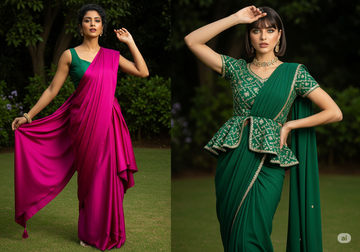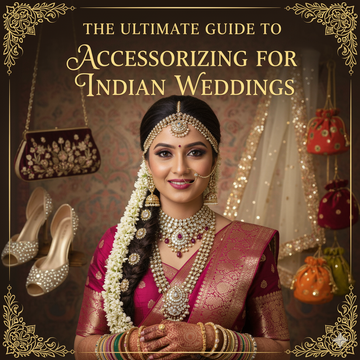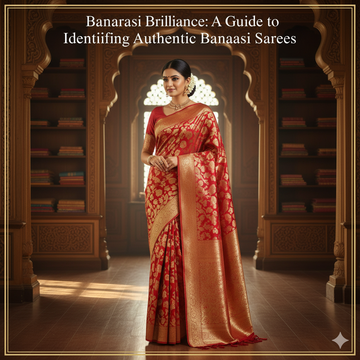Modern Twists to Traditional Draping: Unique Saree Styles for Every Occasion
by Joelpaes . on Jul 30, 2025

Modern Twists to Traditional Draping: Unique Saree Styles for Every Occasion
The saree has never been a static garment. While rooted in heritage, it has always adapted to the world around it. Women today are pushing boundaries, not by discarding tradition, but by reshaping it to fit their lives. This is where modern saree draping styles come into play. These aren’t just gimmicks or passing fads. They reflect deeper changes in how Indian women see themselves and wish to be seen.
From corporate events to rooftop cocktail nights, the six yards have become a versatile canvas. With each unique drape, women are expressing individuality, mood, and intent. The idea isn’t to reinvent the saree but to unlock what it can become. That freedom has led to a surge of contemporary saree looks, many of which blend comfort, boldness, and elegance in equal measure.

Fusion Drapes That Blend Cultures
One of the most exciting trends today is the fusion of Indian silhouettes with global sensibilities. Picture a saree worn over trousers instead of a petticoat. It sounds unconventional, but it works beautifully, especially for those who lean toward minimalism with a twist. Tailored pants not only add structure, but they also allow for freer movement. This fusion is popular at fashion-forward offices, creative networking events, and modern pre-wedding functions.
Another striking example is the saree styled over a belt or corset. This technique defines the waist while maintaining the fluidity of the drape. It’s functional too, especially for those dancing through an evening in a party wear saree. Draping it tightly over a corset top makes the whole look feel secure without compromising elegance. These adaptations are not about seeking attention, but about feeling grounded in one's own skin, while trying something that stands apart.

Elevating Festive Wear with New Textures and Pairings
During festive seasons, there’s a growing trend of pairing old heirloom sarees with edgy or modern blouses. Think of a golden kasavu saree worn with a cropped leather top, or a kanjeevaram paired with a sheer mesh blouse. These aren't mismatches. They're a conscious blending of nostalgia with modern fashion sense. The festive saree has grown from simply being colorful and ornamental. It has become a dialogue between tradition and self-expression.
Textile mixing is another trend that’s gaining ground. A chiffon saree with a handwoven pallu or a printed silk border stitched onto linen brings texture into play. These details make the saree look and feel custom-made, even if it's off the rack. The idea here isn’t just about turning heads. It’s about inviting questions, starting conversations, and wearing something that doesn’t just fit but says something personal.

Statement Drapes for the Bold and Unapologetic
Saree draping styles now go far beyond what a conventional pleat or pallu can offer. Experimental drapes like the butterfly style, dhoti drape, or mermaid silhouette offer a bold shift from what’s familiar. These styles particularly shine when worn as a party wear saree. The fabric clings and moves in unusual ways, allowing the saree to mimic a gown, without losing its identity.
Contemporary saree looks often include asymmetric tucks, half pleats, or even sarees worn like capes. One style that’s making rounds is the pre-stitched pallu that falls like a sash across the body, leaving one hand completely free. These are ideal for events where photos are constant, and movements need to be easy and uninterrupted. It’s no surprise that more women are picking these up for cocktail nights, gallery openings, and even non-traditional weddings.
For those seeking sculptural grace paired with modern elegance, the infinity drape is a captivating choice. This innovative saree draping style is designed to loop endlessly around the body, creating a continuous, flowing silhouette. The pleats are arranged in such a way that they mimic the curves of a ribbon, often wrapping from shoulder to waist and looping back around the arms. This style suits soft, structured fabrics like satin or silk blends that hold the form without becoming too stiff. It has quickly become a favorite among designers who wish to reimagine the saree for red carpets and high-fashion runways. The infinity drape adds depth to contemporary saree looks by introducing geometric motion and a sophisticated fluidity that stands apart from more traditional layouts.

The New Aesthetic for Wedding Guests
For a long time, being a wedding guest came with unspoken codes. Certain fabrics, shades, and blouse styles were deemed appropriate. But that’s changing. The wedding guest saree today is no longer weighed down by rigid expectations. Women are choosing pastels, hand-block prints, and experimental textures even for evening receptions. Instead of trying to match the grandeur of the bride, the focus has shifted to authenticity.
A well-thought-out wedding guest saree often includes layers, such as jackets, embroidered capes, or even long shrugs. These aren’t just add-ons. They provide comfort, warmth during outdoor functions, and a distinct visual narrative. Pairing muted colors with bold accessories or swapping the blouse for an off-shoulder top gives the look a fresh identity. What matters now is personal ease and originality, not simply formality.

Sarees That Suit Everyday Brilliance
Beyond festive and formal events, sarees are slowly returning to daily life. But they’re doing so on new terms. Soft cottons, pre-draped versions, or sarees worn with shirts and sneakers are becoming part of everyday fashion in urban spaces. These aren’t eccentric statements. They’re a return to an idea that the saree doesn’t need a pedestal. It’s enough if it feels right for the moment.
Some women now wear sarees over tank tops or crop tops, paired with high-top sneakers. Others choose drapes that work well for cycling or commuting, sometimes tying the pleats like a lungi or wrapping it tighter around the calves. This shift is not about creating shock value. It is about integrating a beloved garment into a lifestyle that moves quickly and often unpredictably. This is where contemporary saree looks make the strongest impact by quietly reshaping how we see what’s possible.
The evolution of saree draping styles isn’t driven by trend alone. It reflects deeper cultural transitions. Women no longer have to choose between beauty and function, or between heritage and comfort. Whether dressing for a party wear saree night or selecting a festive saree for a quiet home gathering, they’re rewriting the rules. And those rules no longer fit a single script.
There is no longer a single right way to wear a wedding guest saree, nor is there one correct choice for how a festive saree should look. The saree’s real power has always been in its adaptability.
Today, more than ever, saree is being treated as a living garment. One that listens, moves, and evolves with the woman who wears it.





